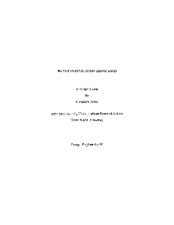| dc.contributor.advisor | Anthony, R. G. | |
| dc.creator | Philip, Elizabeth | |
| dc.date.accessioned | 2013-02-22T20:41:30Z | |
| dc.date.available | 2013-02-22T20:41:30Z | |
| dc.date.issued | 1998 | |
| dc.identifier.uri | https://hdl.handle.net/1969.1/ETD-TAMU-1998-Fellows-Thesis-P49 | |
| dc.description | Digitized from print original stored in HDR. Due to the character of the original source materials and the nature of batch digitization, quality control issues may be present in this document. Please report any quality issues you encounter to digital@library.tamu.edu, referencing the URI of the item. | en |
| dc.description | Includes bibliographical references: leaves 26-27. | en |
| dc.description | Program year: 1997/1998 | en |
| dc.description.abstract | Several novel crystalline silicotitantes were developed at Texas A&M University, one of which is the 1996 R&D 100 Award winning material, TAM5. Although presently the sole use of TAM5 is to clean radioactive wastes, TAM5 has a unique structure that makes it ideal for sodium removal from water systems. Sodium levels of College Station tap water are between 300 and 450 ppm. Sodium removal was achieved by flowing tap water through a fixed bed of TAM5. Only 20g of TAM5, which can be regenerated using only 60ml of 2M HCl, are required to remove sodium from 350 ppm to less than 1 ppm for 3L of tap water. Initial batch experiments involving sodium nitrate and lithium chloride indicate that TAM5 can separate sodium from lithium solutions, which is desirable for the treatment of electrometal-processing waste. TAM5 has proven effective for separating sodium under various conditions. In comparison to literature values for a standard Ultrapure bed, one of the most common ion-exchange resins on the market, TAM5 proved superior. TAM5 can remove 11-20% more sodium than Ultrapure. Thus, a TAM5 column can be used in a cyclic process of sodium removal from drinking water followed by a regeneration step using an acid. | en |
| dc.format.extent | 34 pages | en |
| dc.format.medium | electronic | en |
| dc.format.mimetype | application/pdf | |
| dc.language.iso | en_US | |
| dc.rights | This thesis was part of a retrospective digitization project authorized by the Texas A&M University Libraries in 2008. Copyright remains vested with the author(s). It is the user's responsibility to secure permission from the copyright holder(s) for re-use of the work beyond the provision of Fair Use. | en |
| dc.subject | TAM5 | en |
| dc.subject | crystalline silicotitantes | en |
| dc.subject | sodium removal | en |
| dc.subject | waste treatment | en |
| dc.subject | electrometal processing | en |
| dc.subject | Ultrapure | en |
| dc.title | Water purification using TAM5 | en |
| dc.type | Thesis | en |
| thesis.degree.department | Chemical Engineering | en |
| thesis.degree.grantor | University Undergraduate Research Fellow | en |
| thesis.degree.name | Fellows Thesis | en |
| thesis.degree.level | Undergraduate | en |
| dc.type.material | text | en |
| dc.format.digitalOrigin | reformatted digital | en |


